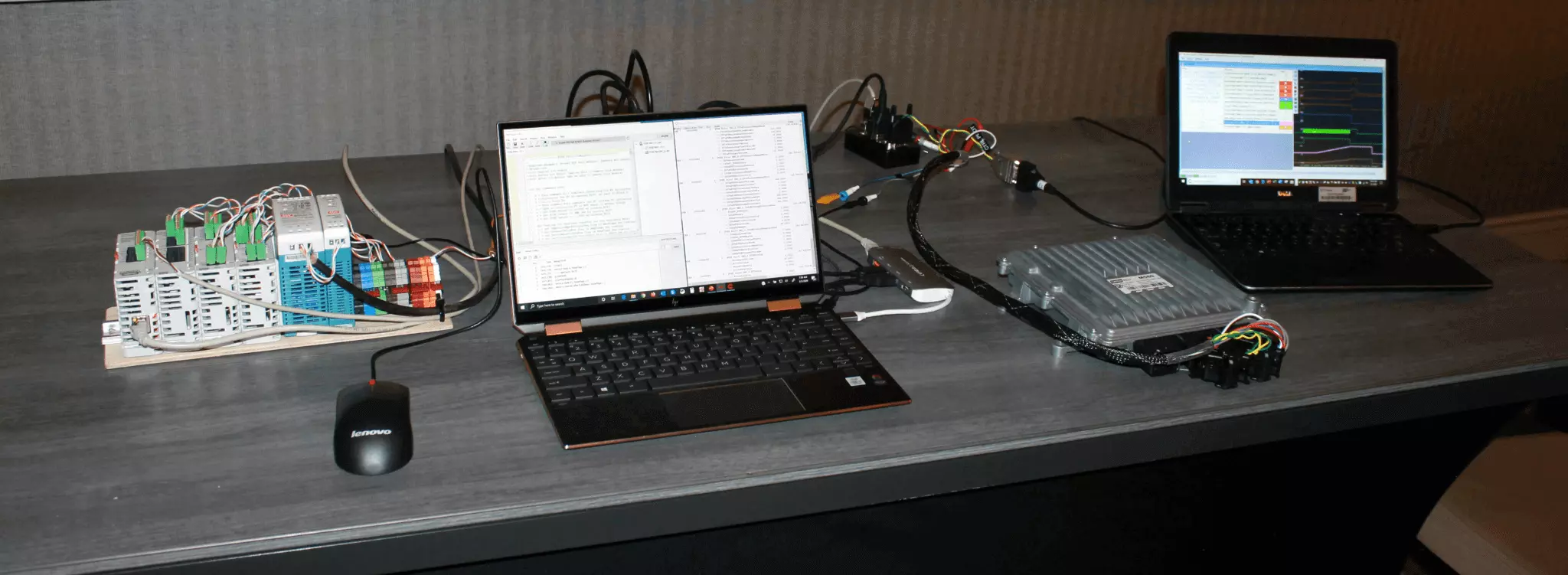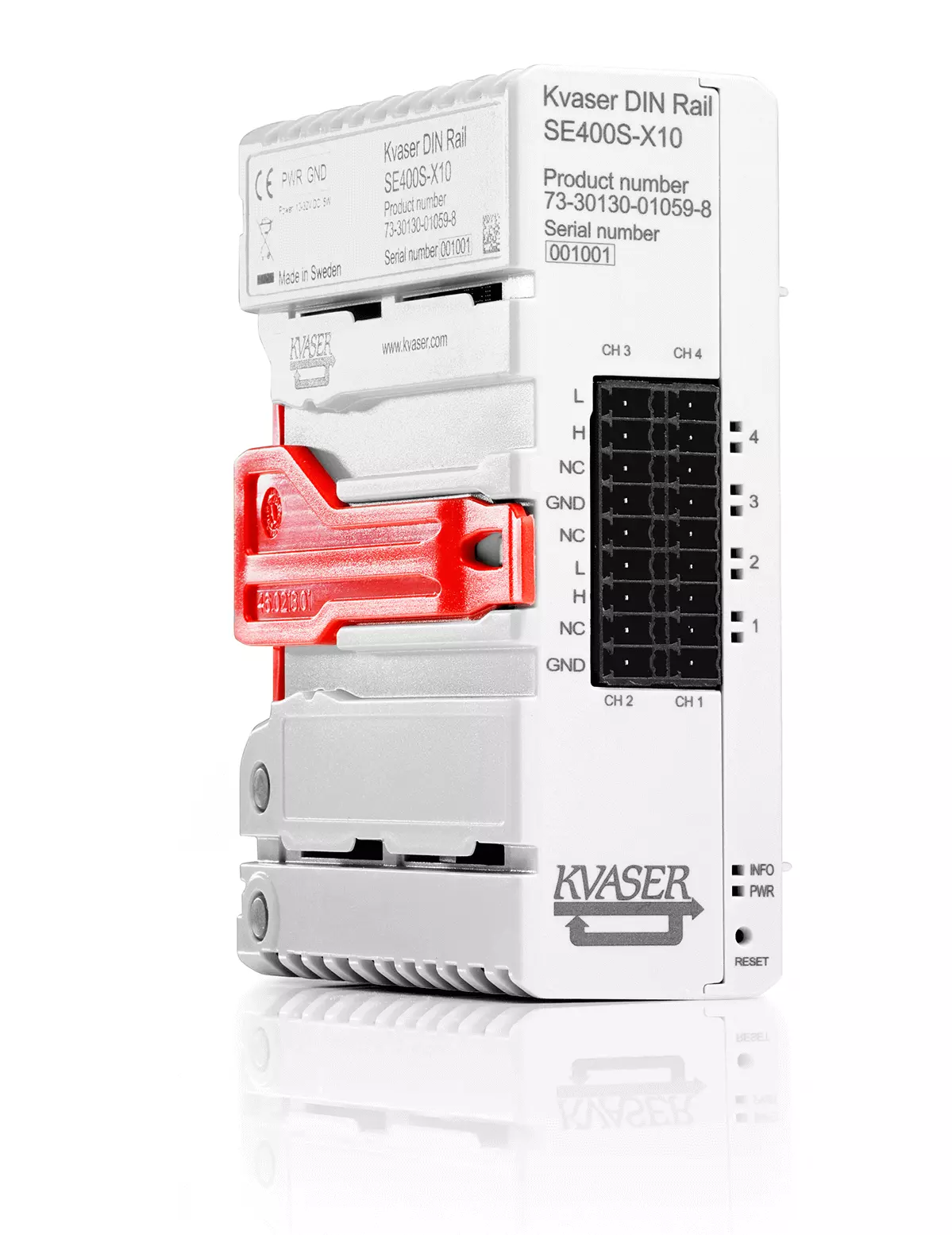Bryan Hennessy, Kvaser Technical Partner Manager, and Amir Rezaei, Senior Control Systems Engineer at Pi Innovo, created a Combined Charging System demonstrator for The Battery Show, North America.
Simulating an Electric Vehicle Charging Station: Battery Show Demo Walkthrough

The system highlighted Pi Innovo’s Combined Charging System and Open ECU to implement the charging protocol in a battery management system, while Kvaser’s DIN Rail products and t program scripting language were utilized as an Electrical Vehicle Supply Equipment (EVSE) simulation and test circuit, to provide simulated hardware and software handshakes.

The end goal was to demonstrate the Combined Charging System’s ability to manage a CAN-based electric charging session.
The full demonstration configuration consisted of two systems:
- Pi Innovo’s Combined Charging System and Open ECU units
- Kvaser’s DIN Rail 400SE-X10-based simulation and test circuit

Combined Charging System (CSS)
Pi Innovo’s Combined Charging System (CCS) is an applications source code product provided in Simulink models that implements IEC 61851-1, DIN 70121, SAE J2847 and SAE J1772 charging system development.
M560 and M580 OpenECU modules are combined with CCS for development of a complete vehicle charging system.
The CCS was loaded onto the OpenECU module and used to manage the series of CAN-based interactions during the simulated vehicle charging session.
Rezaei explains:
“OpenECU M560 and M580 are designed to meet ISO 26262 ASIL D functional safety for complex hybrid and EV control applications…
These control units are also equipped with the required hardware to interface and communication data with offboard AC and DC chargers. The OpenECU platform supports model-based programming in Simulink and runtime software calibration with different calibration tools such as ATI Vision, CANape, INCA or Pi Snoop.”
EVSE simulation and test circuit
An Electrical Vehicle Supply Equipment (EVSE) used Kvaser DIN Rail modules, a resistor network and t programming to provide simulated hardware and software handshakes..
The new Kvaser DIN Rail hardware was used because of the need for digital and analogue I/O and controllable relays provided by the I/O modules that are optically coupled with the SE400X-X10 controller.
External circuits were needed to provide the hardware handshake required to detect connection to the vehicle, and manage the hardware handshakes required to simulate the charging sequence .
Commented Hennessy:
“Kvaser’s DIN Rail products offer complete flexibility when creating simulation and/or test circuits that incorporate CAN interfaces. With all the I/O, plus four CAN channels, relays for higher voltages, analog functions, and the complete power of CANlib SDK or t programming to create test or simulation code, this system gives engineers an easy way to build exactly what they need.”

Kvaser’s t program scripting language was used for its ease in CAN message generation and reception, light weight and free Integrated Development Environment, and functionality with multiple Kvaser Pro products
Summary
The result was a simple, effective demonstration of battery charging communication.
Pi Innovo’s OpenECU M560 or M580 supervisory controllers and the OpenECU software platforms showed the ability to implement whichever AC or DC charging protocol is required, in accordance with SAE J1772 and DIN SPEC 70121.
The EVSE provided by Kvaser simulated the hardware and software handshakes required. The EVSE also helped Pi Innovo validate error handling code, message timing variations handling, charge interruption routines, and many other charging situations that are difficult to reproduce on the bench.
Further Reading
- Pi Innovo’s Combined Charging System:
www.pi-innovo.com/product/combined-charging-system-ccs - Pi Innovo’s OpenECU: www.pi-innovo.com/open-ecu
- Kvaser DIN Rail SE400S-X10: www.kvaser.com/product/kvaser-din-rail-se400s-x10/
- Kvaser Termination Adaptor:
www.kvaser.com/product/kvaser-d-sub-9-pin-120-ohm-termination-adapter-2/ - Kvaser T-Cannector v2: www.kvaser.com/product/kvaser-t-cannector-v2/
- Kvaser t Programming: https://www.kvaser.com/t-programming/

 youku
youku